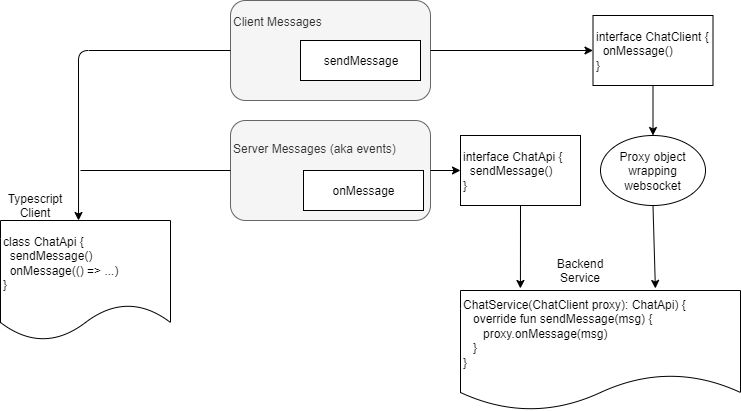Inspired by recent work on an automatically-generated HTTP API I took a look at our WebSocket API. We had types defined on our backend, and some were shared by our frontend thanks to the typescript-generator plugin, but it was a hodge-podge of hand written TypeScript types and for loops with casts to try to ensure the frontend and backend stayed in sync - in other words, we had a lot of code that described the plumbing rather than doing useful things. Here I’ll demonstrate how we manage to share WebSocket calls, listeners, and types across our frontend and backend, ending up with a single clear and concise interface for us to use.
Want to skip the explanation and just check out the code? Here you go.
The old way: Building a bridge from both ends
Our websocket client code would send messages to our backend, which would handle the message and forward it on, hopefully to the right destination.

In reality, keeping track of what messages contained what fields, where they were supposed to go, and who was allowed access got messy pretty quickly.

The new way: A clearly defined interface(s)
Let’s group our messages in two:
- Messages sent from the client
- Messages sent from the server

This separation gives us a hint on how we can separate our calls in code in terms of how we handle it. So we build two interfaces for our WebSocket service, one for each category:
ChatApi, with methods likesendMessage()for when a client initiates an actionChatEvents, with methods likeonSendMessage()for when a client receives an action from the server
These two can be combined into a single TypeScript file for clients to use. The server side is a little more complicated; here’s how I did it:
- Bind all methods from
ChatApito an implementation, and redirect websocket messages to this implementation - Create a proxy object that implements
ChatEvents, redirecting any calls to it to a list of WebSocket sessions that have registered for that event - Add a special extra “register” method to our WebSocket connection, that allows clients to add themselves to the list of sessions in the client.

The result is client code that looks like this:
const api = new ChatApi({onOpen: () => console.log("connected")})
api.onMessage(msg => setMessages([...messages, msg]))
//...
api.sendMessage("Wow, that was easy!")
With our TypeScript file clearly defining how to interact with our backend, a little bit of reflective Kotlin code connecting our WebSocket connection to our backend implementation, and typescript-generator to share types, we couldn’t have a safer, easier to use API.
Who listens to what?
Not every message should go to every client. For example, in a chat app, private messages should only go to their destination. I handled this with a special annotation on method parameters that allow filtering of destinations:
interface ChatEvents {
// listening to the "onMessage" event will get all group message events
fun onMessage(message: String, from: String)
// In this case, you'll listen for "onPrivateMessage/<username>" events
// to ensure you only receive messages meant for you
fun onPrivateMessage(@Filter to: String, message: String, from: String)
}
By default messages are sent to every listener - but perhaps you might want to filter messages from being sent back to the caller? I haven’t done so but depending on your use case this might be worth considering.
Show me the code!
I’ve uploaded a simple demonstration on Github if you’d like to dig into the details on how it works.
Comments